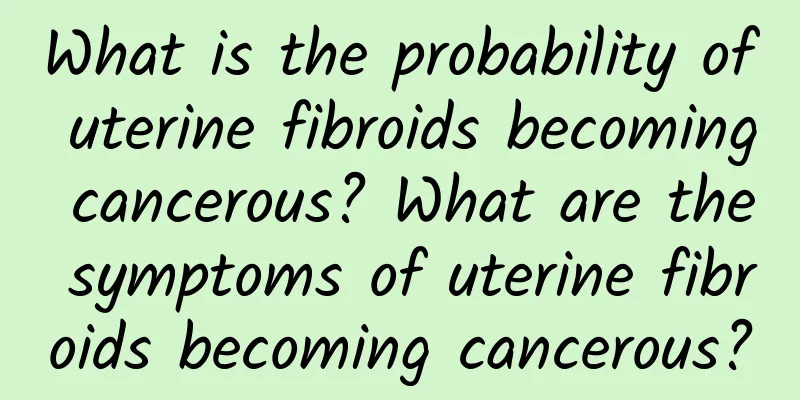What is the probability of uterine fibroids becoming cancerous? What are the symptoms of uterine fibroids becoming cancerous?

|
What is the probability of uterine fibroids becoming cancerous? What are the symptoms of uterine fibroids becoming cancerous? In recent years, uterine fibroids have become one of the most common reproductive organ diseases in women. However, many people know little about the chances of uterine fibroids becoming cancerous and the related symptoms. This article will explore these two issues in depth to help readers better understand the characteristics of uterine fibroids and related health problems. We need to clarify what is the cancer rate of uterine fibroids. Uterine fibroids are a common benign muscle tumor that usually grows on the wall of the uterus. Most uterine fibroids are benign, and only a few will develop into malignant tumors, that is, cancer of uterine fibroids. According to research, the cancer rate of uterine fibroids is approximately between 0.1% and 0.5%. This means that only a very small number of patients will experience cancer of uterine fibroids, and most patients can rest assured. However, despite the low chance of cancer, the symptoms of uterine fibroids cannot be ignored. Although most uterine fibroids have no symptoms, some cases have the following symptoms: 1. Severe abdominal pain: When uterine fibroids grow larger, they may compress nearby tissues and organs, causing severe abdominal pain. This pain often worsens with the menstrual cycle, but usually subsides after the menstrual period. 2. Irregular menstruation: Uterine fibroids may interfere with the normal menstrual cycle and make it irregular. Some women may experience increased menstrual flow, shortened or prolonged menstrual cycles, etc. 3. Frequent urination and urgency: The growth of uterine fibroids may put pressure on the bladder, causing frequent urination and urgency. This is because the tumor increases the sensitivity of the bladder, making women feel the need to urinate frequently. Although the above symptoms may be related to other gynecological problems, if they occur together with uterine fibroids, then it is necessary to conduct relevant tests and diagnosis. Doctors usually perform physical examinations, ultrasounds, MRIs or CT scans to confirm the diagnosis. So, how can you reduce the chances of uterine fibroids becoming cancerous and better manage their associated symptoms? Here are some suggestions: 1. Regular check-ups: Regular gynecological examinations are the key to preventing and early detection of uterine fibroids. Regular check-ups can help doctors detect changes in fibroids early and treat them. 2. Healthy lifestyle: Maintaining a healthy lifestyle can help prevent and manage uterine fibroids. This includes eating a balanced diet, reducing alcohol and caffeine intake, and getting moderate exercise. 3. Non-surgical treatment: For most benign uterine fibroids, non-surgical treatments are usually sufficient. Drug therapy and partial interventional therapy are some common non-surgical treatments. However, in some cases, surgery may be a necessary option. Although uterine fibroids have a low chance of becoming cancerous, the symptoms of the disease may have an adverse effect on the patient's health and quality of life. Therefore, it is important to understand the symptoms and management of uterine fibroids. Through regular checkups, a healthy lifestyle, and appropriate treatment, we can effectively prevent and manage problems related to uterine fibroids to maintain good health and quality of life. |
Recommend
What to do if you reach menopause at the age of 40
Menopause in your forties may be a sign of premat...
Revealed: What are the causes of mild cervical hyperplasia?
According to recent survey statistics, about 70% ...
How much does a painless abortion surgery cost?
With the development of the times, people's m...
How does Traditional Chinese Medicine treat pelvic peritonitis?
Maybe everyone knows something about pelvic perit...
How to prevent vaginitis?
How to prevent vaginitis? Vaginitis often trouble...
Can taking soy isoflavones help menstruation after menopause? When is the best time to take soy isoflavones?
When women reach a certain age, their menstrual f...
Don't be afraid of Ashes of Time and West Poison. 4 tips to save money and detox
In order to maintain good health, regular detoxif...
What causes pelvic inflammatory disease?
Pelvic inflammatory disease is caused by inflamma...
Why does my period at the age of 50 come once every two months and why is the amount of blood heavy?
Why does my period at the age of 50 come once eve...
What causes uterine fibroids? What are the symptoms of uterine fibroids?
What causes uterine fibroids? Understanding their...
Office workers should prevent abdominal obesity! Wu Mingzhu's push and lift move...
Office workers who sit for long periods of time s...
How to cure female cervical erosion? Women must know 3 physical treatments for cervical erosion
As we all know, the cervix plays a very important...
What are the symptoms of chronic cervicitis? 4 symptoms of chronic cervicitis should be paid attention to
Chronic cervicitis is a common gynecological dise...
Factors causing recurrence of cervical warts
The factors that make cervical warts uncurable fo...
Surgical method of negative pressure aspiration for artificial abortion
The preoperative preparation for negative pressur...









